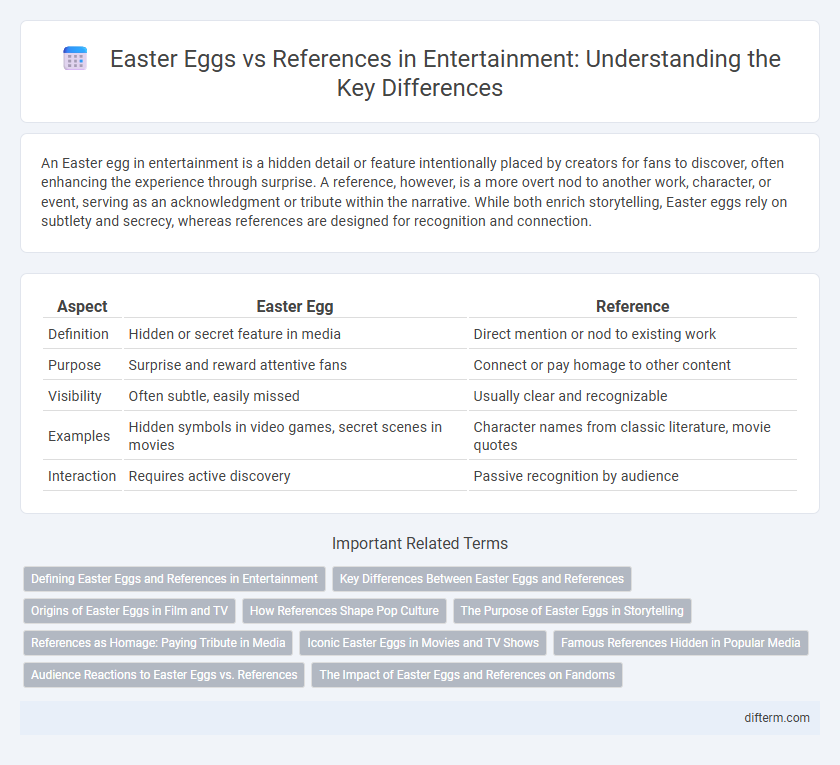An Easter egg in entertainment is a hidden detail or feature intentionally placed by creators for fans to discover, often enhancing the experience through surprise. A reference, however, is a more overt nod to another work, character, or event, serving as an acknowledgment or tribute within the narrative. While both enrich storytelling, Easter eggs rely on subtlety and secrecy, whereas references are designed for recognition and connection.
Table of Comparison
| Aspect | Easter Egg | Reference |
|---|---|---|
| Definition | Hidden or secret feature in media | Direct mention or nod to existing work |
| Purpose | Surprise and reward attentive fans | Connect or pay homage to other content |
| Visibility | Often subtle, easily missed | Usually clear and recognizable |
| Examples | Hidden symbols in video games, secret scenes in movies | Character names from classic literature, movie quotes |
| Interaction | Requires active discovery | Passive recognition by audience |
Defining Easter Eggs and References in Entertainment
Easter eggs in entertainment are hidden messages, inside jokes, or secret features subtly embedded for fans to discover, often enhancing engagement and replay value. References are explicit nods or allusions to other works, characters, or cultural elements that enrich the narrative or connect universes without requiring fan discovery. Both techniques deepen audience experience but differ in visibility and intent, with Easter eggs relying on concealment and references on recognition.
Key Differences Between Easter Eggs and References
Easter eggs in entertainment are hidden messages, features, or inside jokes intentionally embedded for dedicated fans to discover, often requiring exploration or prior knowledge. References explicitly mention or allude to external works, characters, or events to create connections or pay homage, making them more overt and accessible. The key difference lies in Easter eggs being concealed surprises that reward attentive audiences, while references serve as direct nods to related content.
Origins of Easter Eggs in Film and TV
Easter eggs in film and TV originated as hidden messages or inside jokes embedded by creators to engage attentive audiences, dating back to the 1979 video game Adventure where the first known Easter egg was discovered. These subtle inclusions differ from straightforward references by being deliberately concealed to reward viewers who notice them, enhancing fan interaction and deeper narrative appreciation. The practice has since evolved into a widespread tradition across the entertainment industry, enriching viewer experience through layered storytelling.
How References Shape Pop Culture
References in entertainment serve as cultural signposts that connect audiences to shared experiences, enriching storytelling by invoking familiar themes, characters, or moments from other works. Easter eggs, often hidden and subtle, reward dedicated fans with insider nods that deepen engagement and encourage community discussion. These references collectively shape pop culture by fostering intertextuality, creating a layered narrative landscape where new creations converse with past influences.
The Purpose of Easter Eggs in Storytelling
Easter eggs in storytelling serve to deepen audience engagement by rewarding dedicated fans with hidden clues or nods that enhance the narrative experience. Unlike straightforward references, Easter eggs often carry layered meanings, creating a richer, interactive connection between the story and its viewers. These subtle inclusions can build community, encourage rewatching or rereading, and foster a sense of insider knowledge among audiences.
References as Homage: Paying Tribute in Media
References in media serve as homage by explicitly acknowledging influential works, creators, or cultural icons, enriching the audience's experience through recognition and appreciation. These tributes often highlight the creative lineage and celebrate the impact of original material, fostering a deeper connection between the new content and its predecessors. Unlike subtle Easter eggs, references are designed to be clear nods that honor and preserve the legacy within entertainment narratives.
Iconic Easter Eggs in Movies and TV Shows
Iconic Easter eggs in movies and TV shows often serve as hidden nods to creators, fans, or other works, enriching the viewing experience through subtle intertextuality. Unlike direct references, Easter eggs require keen observation to discover, such as the Marvel Cinematic Universe's continuous inclusion of Stan Lee cameos or the recurring Pizza Planet truck in Pixar films. These carefully placed elements create a layered narrative that rewards attentive audiences and strengthens franchise lore.
Famous References Hidden in Popular Media
Famous references hidden in popular media serve as deliberate nods to previous works, enriching the viewer's experience by establishing a shared cultural context. Unlike Easter eggs, which are subtle, often playful secrets intended to surprise the audience, references explicitly acknowledge iconic films, books, or events, deepening narrative layers. Examples include Marvel's use of Stan Lee cameos that pay homage to comic book history and Quentin Tarantino's films referencing classic cinema tropes and dialogue.
Audience Reactions to Easter Eggs vs. References
Audience reactions to Easter eggs often include excitement and a sense of insider knowledge, as these hidden elements reward attentive viewers with a unique discovery. References trigger recognition and nostalgia, connecting audiences to familiar works and enhancing engagement through shared cultural touchstones. Both Easter eggs and references deepen viewer investment, but Easter eggs uniquely foster a playful, interactive experience that encourages repeat viewings.
The Impact of Easter Eggs and References on Fandoms
Easter eggs and references in entertainment foster deeper engagement by rewarding observant fans with hidden details or nods to other works, enhancing the immersive experience. These elements create a sense of community and shared knowledge within fandoms, driving discussion, theories, and fan-created content. Their strategic use influences fan loyalty and contributes to the longevity and cultural impact of media franchises.
Easter egg vs reference Infographic

 difterm.com
difterm.com